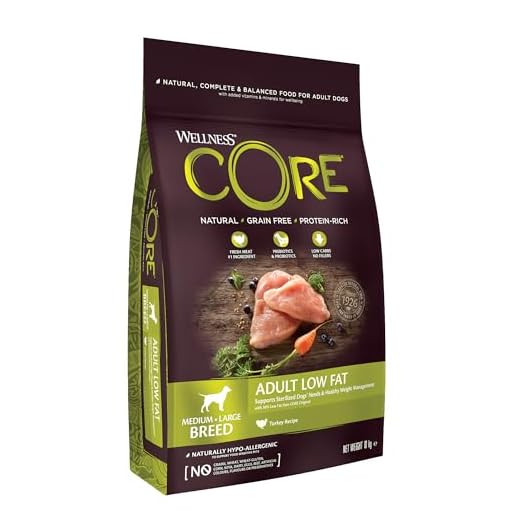




Most canines show noticeable improvement within a week after a diagnosis of pancreatic inflammation. The initial phase often involves a strict, low-fat diet and plenty of rest. During this critical time, monitoring hydration levels and ensuring access to fresh water is vital.
By the second week, many pets return to their normal behaviour and appetite, although a gradual reintroduction of regular food is advisable. It’s essential to consult with a veterinarian regarding the right time to adjust their diet, as individual recovery rates can vary significantly.
Full recovery may take two to four weeks, depending on the severity of the condition and the effectiveness of the treatment plan. Regular check-ups are crucial to assess progress and prevent any potential complications. Always observe for signs of discomfort or setbacks, as early intervention can make a significant difference in the healing process.
Recovery Time for Canine Pancreatic Issues
Typically, noticeable improvement can occur within a few days to a week after initial treatment. However, complete healing may take several weeks, depending on the severity of the condition and individual health factors. During this period, it’s crucial to monitor your pet closely and follow your veterinarian’s dietary recommendations.
A gradual return to regular feeding habits is advisable. Start with bland, low-fat meals that are easy to digest. Once your furry friend shows signs of stability, you can begin transitioning to a more balanced diet. Opting for best dog food with whole grain can aid in the recovery process, providing necessary nutrients without overburdening the digestive system.
Regular veterinary check-ups are vital during this time to ensure proper recovery. If any unusual symptoms arise, such as vomiting, lethargy, or changes in appetite, seek immediate attention. Each case is unique, so patience and attentive care are essential for a successful outcome.
Understanding Canine Pancreatitis Symptoms
Immediate recognition of signs is crucial. Look out for persistent vomiting, loss of appetite, lethargy, and abdominal pain. Affected pets may adopt a hunched posture, which indicates discomfort. Keep an eye on their behaviour; if they seem unusually withdrawn or reluctant to engage, this could signal distress.
Diarrhoea is another common symptom, often accompanied by a foul smell. Sometimes, the stool may appear greasy or contain undigested food. If you notice these changes, consult a veterinarian quickly. Dehydration may occur due to vomiting and diarrhoea, so ensure fresh water is always available.
Fever can also be present, signalling inflammation. A quick temperature check can help identify this issue. If the temperature exceeds 39.2°C (102.5°F), seek veterinary assistance. Monitoring these symptoms allows for timely intervention, which is key to managing the condition effectively.
Be observant of any changes in behaviour or routine. Increased sensitivity to touch, especially around the belly, can indicate pain. If your furry friend suddenly seems more irritable or anxious, this may be a sign of discomfort. Always trust your instincts; if something feels off, don’t hesitate to reach out to your vet.
Understanding these signs can make a significant difference in treatment outcomes. Prompt action can lead to better management of the situation and enhance your pet’s well-being. Pay attention to the nuances of their behaviour, as they can provide valuable insights into their health status.
Factors Influencing Recovery Time in Dogs
Age significantly impacts the healing process. Younger animals generally bounce back more quickly due to their robust immune systems, while older companions may experience prolonged recovery due to pre-existing health conditions.
Dietary Changes
Nutrition plays a key role in the healing phase. A low-fat diet is often recommended to ease the burden on the pancreas. Transitioning to a bland diet, such as boiled chicken and rice, can be beneficial. It’s essential to introduce new foods gradually to monitor tolerance.
Underlying Health Issues
Concurrent health problems can complicate the situation. Conditions like diabetes or liver disease may extend the duration of recovery. Regular veterinary check-ups are vital for addressing these complications promptly.
Stress levels also affect the timeline. A calm environment aids in quicker recuperation, so providing a quiet space during the healing process can be advantageous.
Finally, adherence to veterinary advice is crucial. Following prescribed medications and treatment plans ensures the best chance for a swift return to health. Regular monitoring and communication with the vet are essential for adjustments based on the pet’s progress.
Typical Recovery Timeline for Mild Cases
In instances of mild inflammation of the pancreas, the time needed for improvement is generally between three to seven days. Symptoms like vomiting and loss of appetite usually diminish significantly within the first 48 hours following treatment. A gradual return to regular feeding often begins after this initial period, allowing the pet to regain strength and energy.
Day-by-Day Expectations
During the first couple of days, it’s common to observe your furry friend resting more than usual. This is a sign that their body is focusing on healing. The veterinarian may recommend a bland diet, typically low in fat, to ease digestion.
| Day | Symptoms | Feeding Recommendations |
|---|---|---|
| 1 | Vomiting, lethargy | No food, clear water only |
| 2 | Decreased vomiting, increased alertness | Bland diet (boiled chicken, rice) |
| 3-4 | Significant improvement in energy, normal behaviour | Gradual reintroduction of regular food |
| 5-7 | Near normal behaviour, occasional mild discomfort | Full return to regular diet if tolerated |
Monitoring Progress
Throughout this period, close observation is essential. Any signs of a setback, such as recurring vomiting or lethargy, warrant immediate veterinary attention. Regular follow-ups can help ensure that everything is on track, and adjustments to the treatment plan can be made as necessary.
Expected Recovery Duration for Severe Cases
In severe instances, the timeline can extend significantly, often ranging from several days to weeks. Hospitalisation is frequently required, with intensive care lasting about three to seven days, depending on the dog’s condition and response to treatment.
During this period, monitoring for complications is critical. After stabilisation, a gradual transition to a bland diet may occur, typically beginning one to two days post-discharge. Full dietary recovery might take an additional week or more as the animal adjusts to regular feeding.
Follow-up veterinary visits are essential, usually scheduled one to two weeks after initial treatment. These appointments allow for reassessing the health status and making necessary dietary adjustments. Some pets may exhibit lingering symptoms or need longer recovery due to underlying health issues.
In total, expect a comprehensive recovery period of two weeks to several months. The exact duration varies widely based on individual health, age, and adherence to dietary guidelines. Patience and close observation during this time are paramount for ensuring a successful return to normalcy.
Role of Diet in the Recovery Process
Choosing the right nutrition is crucial during the healing phase. A low-fat diet is highly recommended, as it significantly reduces strain on the pancreas. Lean proteins and easily digestible carbohydrates should form the basis of meals.
Here are some dietary guidelines to consider:
- Low-fat protein sources: Chicken breast, turkey, and fish can be beneficial.
- Complex carbohydrates: Brown rice, sweet potatoes, and oats provide energy without overwhelming the digestive system.
- Small, frequent meals: Offering smaller portions multiple times a day can ease digestion and prevent overworking the pancreas.
- Hydration: Fresh water should always be available to ensure adequate hydration, especially if vomiting or diarrhoea occurs.
Always consult with a veterinarian before making any dietary changes. They may recommend specific commercial diets designed for recovery, formulated to support healing and ensure nutritional balance.
Introducing new foods should be gradual. Start with small amounts and monitor for any adverse reactions. Gradually reintroducing regular food after the recovery period can help determine what works best.
Incorporating supplements, like omega-3 fatty acids, may help reduce inflammation, but again, professional advice is key. The right dietary choices can greatly influence the speed of healing and overall health post-illness.
Signs Your Pet is Not Recovering as Expected
Watch for persistent vomiting or diarrhoea after initial improvements. If your furry friend shows ongoing gastrointestinal distress, it may indicate complications or inadequate healing.
Monitor appetite closely. A sudden loss of interest in food, especially after a period of eating well, can signal an underlying issue. If your companion refuses meals for more than a day, consult a veterinarian.
Pay attention to energy levels. A lack of enthusiasm for walks or playtime could suggest discomfort or a setback in their condition. If your canine companion seems lethargic, it’s a sign to seek professional advice.
Keep an eye on hydration. Dehydration can quickly become a critical concern. If your pet is drinking less than usual or showing signs of dry gums, it’s important to address this promptly.
Observe any behavioural changes. Increased irritability or withdrawal may indicate pain or discomfort. If your four-legged friend appears more anxious or restless than normal, it’s worth investigating further.
Look out for abdominal distension or tenderness. If the belly feels hard or your pet flinches when you touch it, this could point to serious issues requiring immediate veterinary attention.
Track weight fluctuations. Sudden weight loss or gain can be a red flag. Regular weigh-ins can help identify these changes early, allowing for timely intervention.
Lastly, keep up with follow-up appointments. Regular check-ups are crucial to monitor recovery progress. If your vet expresses concern during these visits, take their advice seriously.
FAQ:
How long does it usually take for a dog to recover from pancreatitis?
The recovery time for a dog suffering from pancreatitis can vary significantly based on the severity of the condition and the individual dog’s health. Generally, mild cases may see improvement within a few days with proper treatment, while more severe cases could take several weeks. Regular follow-ups with a vet are important to monitor the dog’s progress and adjust the treatment plan as needed.
What factors influence the recovery time for dogs with pancreatitis?
Several factors can impact the recovery time for dogs with pancreatitis. These include the dog’s age, overall health, the severity of the pancreatitis, and how quickly treatment was initiated. Dogs with pre-existing health issues or those that are older may take longer to recover. The type of treatment administered, such as dietary management and medication, also plays a significant role in the recovery process.
Are there specific signs that indicate a dog is recovering from pancreatitis?
Yes, there are several signs that may indicate a dog is recovering from pancreatitis. These include a return of appetite, increased energy levels, normal bowel movements, and a reduction in abdominal pain or discomfort. Regular veterinary check-ups are essential to ensure that the dog is healing properly and to monitor for any potential complications.
What should I do to help my dog during its recovery from pancreatitis?
To support your dog during recovery from pancreatitis, it is important to follow your veterinarian’s recommendations closely. This may include providing a special low-fat diet, ensuring your dog stays hydrated, and monitoring their activity level. It’s also advisable to keep a close eye on their symptoms and report any changes to your vet. Patience and care during this time are crucial for a successful recovery.










